- The Hidden Scotland Weekly
- Posts
- Sunday 6th July 2025
Sunday 6th July 2025
Hello and welcome to the Hidden Scotland Weekly

Sunday 6th of July 2025
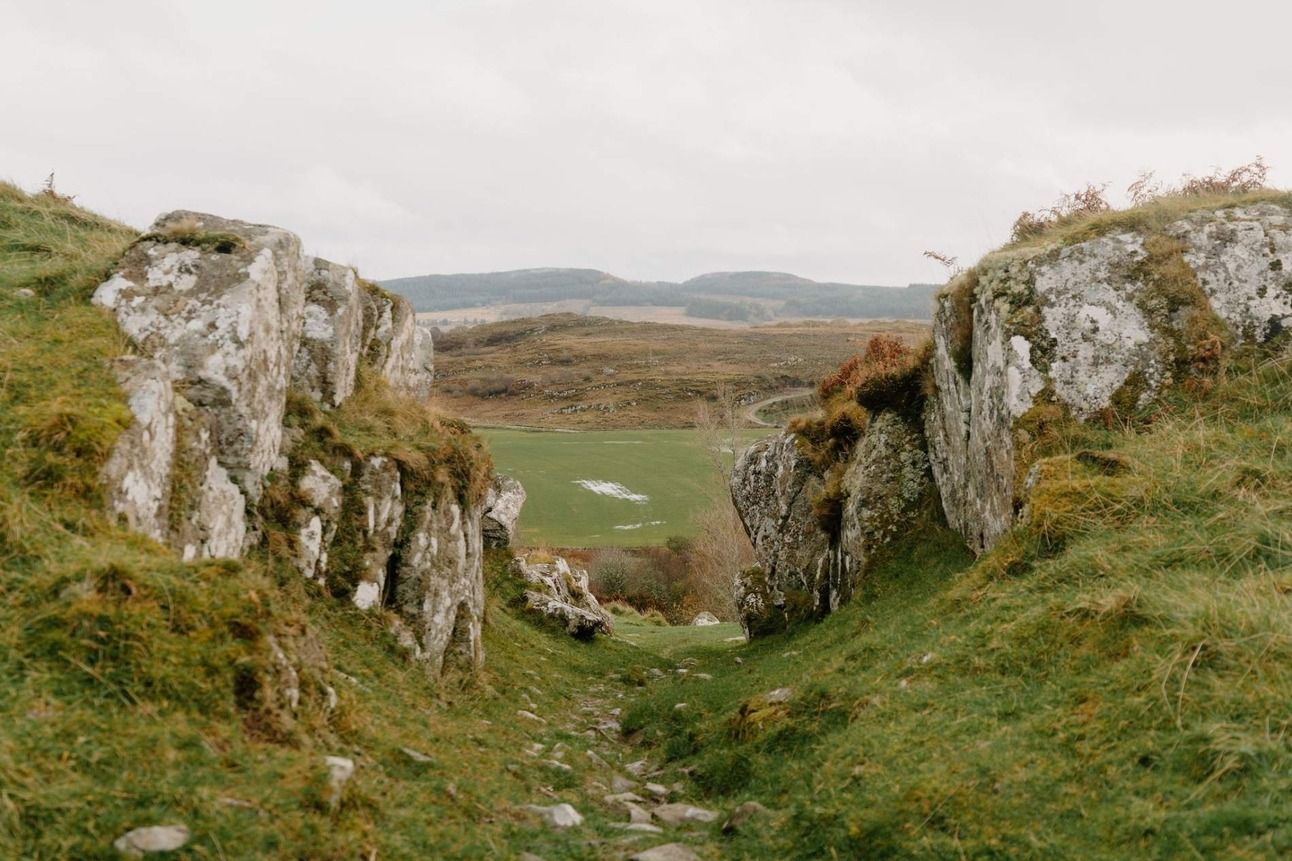
Dunadd Fort by Sam Rogers
Today's weekly takes approximately 14 minutes to read.
Hi 👋
Summer’s moving fast, but we’ve packed this week’s Hidden Scotland Weekly with places, stories, and ideas worth slowing down for.
First, a new itinerary through Mid‑Argyll takes you from standing stones to sea views, stopping at places that often slip beneath the radar. Then we take a closer look at Scotland’s growing food truck scene—from roadside seafood shacks to mobile coffee vans in the Highlands. And finally, a piece of folklore from Graeme Johncock tells the story of the Ghillie Dhu, a woodland figure said to have protected lost children near Gairloch.
We’ve also launched something we’ve been building behind the scenes—Hidden Scotland Membership. Members get full access to our digital collection: back issues of the magazine, all guidebooks, curated itineraries, personalised recommendations, daily quiz, and more. We’ll be sharing more about it soon, but we’d love to welcome a few early readers. There’s a small thank-you gift waiting for the first sign-ups.
And if you're browsing today, there are new arrivals in the shop: a brand new collection from Skíō Pottery, a fresh selection of Scottish books and greeting cards, and the launch of our new Fyfe Golf range. Everything’s available online or in-store at Milton of Crathes.
Thanks, as always, for being part of it.
What’s in this week’s email.
This Week’s Quiz
The Food Truck Revolution
A Day Exploring Mid-Argyll - An Itinerary
Did you know…
Story of the Ghillie Dhu,
What’s new on the website
Quiz Answers

1.Which is the smallest of the five Scotch Whisky regions?
2.What name did Bonnie Prince Charlie use while disguised as a maid?
3.What is the name of the mansion built by Walter Scott?
Did you know we publish a new quiz every day at midnight? Hidden Scotland Members get exclusive access to our daily quiz — a quick way to test your knowledge of Scotland’s history, places, language, and folklore. If you enjoy our weekly three-question teaser, you’ll love the full version.

The Food Truck Revolution
RIP the battered old burger van. You might still spot the odd mobile greasy spoon parked in a layby, but Scotland’s increasingly vibrant food scene has sprouted a culinary side-shoot – a gourmet food truck culture.
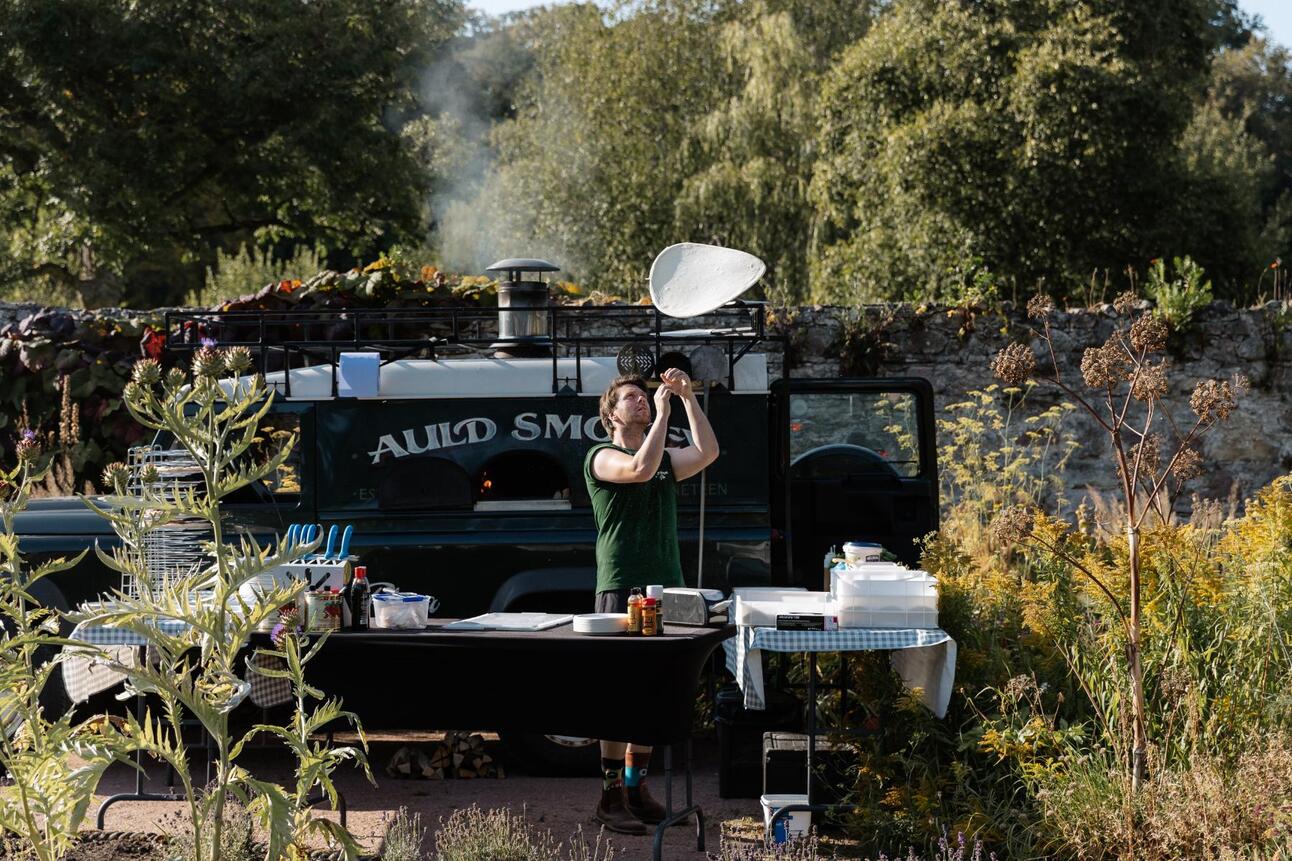
Auld Smokey Pizza
Around the country, food-to-go has never been so inventive and varied. At festivals, fairs and farmers’ markets, beauty spots and beaches you’ll find a fleet of horseboxes, caravans and old Land Rovers converted into hip mobile kitchens and offering a gallop around the globe from Italy to India, Mexico to the Middle East.
In Edinburgh, Sicilian street food from cannolo to caponata di melanzane is dished up by Mizzica Sicilian Deli. Shrimpwreck’s van hands out shrimp sarnies, their signature King prawns in a light batter with bacon jam, pickles, red onion and Marie rose sauce at locations such as West Sands beach in St Andrews (their permanent pitch is the seafood shack on Portobello prom). Or head to Leith Market (19 July and 16 August) and the Fringe by the Sea (1-10 August) for a plate of sauteed truffle gnocchi, mushroom ragout, parsley cream, crispy onions and rocket courtesy of award-winning vegan van Planet G.
Up in Inverness the Highland Food and Drink Trail is a dedicated street food zone on the banks of the River Ness in front of the cathedral with a revolving line-up bringing a new style of food experience to the city. Tuck into tasty Spanish tapas (@nadasbravas) oak-smoked brisket, pork infused with hickory in tacos, toasties and buns (@smokyness_catering) wrapping up with a portion of sticky-fingered, honey-sweet baklava (@thefalafelshop24).
Keep your eyes peeled too for The Angry Seagull the winner of Scotland’s best mobile fish and chips in 2024. Their traditional haddock and chips with a slice of lemon and homemade tartare sauce is the go-to, of course, but weekly changing specials include a ‘Posh Kebab’: spiced lamb kofta, gull mint and garlic yogurt, flatbread and spicy tomato sauce along with the ‘Venimoo Burger’ an Ardgay Game venison pattie, Ardgay beef pattie, smoked cheese, homemade bacon jam and Dijonnaise sauce in a brioche bun.

The Angry Seagull Fish and Chips
Or how about a handmade, wood-fired pizza - out of the back of an old Land Rover Defender? “We’re all about using the best ingredients we can get our hands on — and keeping things as local as possible,” Auld Smokey’s Lewis Lilburn explains. The bestsellers are ‘Something Scottish’, that’s venison salami, Stornoway black pudding, pickled onion, rocket, grated parmesan and a touch of whisky honey and ‘Feelin’ Peachy’ with grilled peaches, prosciutto, rocket and a balsamic glaze. “People go mad for them.” They work closely with local suppliers such as Great Glen Charcuterie to “help us keep our flavours rooted in the Highlands.” They’ve a full summer ahead, down by the river in Inverness and at Aboyne Highland Games so keep an eye on their socials to find out where they’ll be next (@auldsmokeypizza).
And then there’s the legendary Dores Inn (@thedoresinn.scot) perched above the pebbled beach on Loch Ness and now part of the Wildland stable. It might be closed for renovations but they’ve put a couple of sleek burgundy shepherds hut-style Wild Food Trucks in the grounds, a giant stretch tent for shade and sturdy wooden potted herb-peppered tables. On the menu, celebrating Scotland’s culinary landscape and artisan producers, there’s Wildland flatbreads filled with venison salami, pickles and smoked Dunlop cheese, and crispy cod, tartare sauce and crushed pea salad. You can quench your thirst at the separate drinks and dessert truck with fresh garden juices, organic ice cream and strawberry sorbet, then wander down to the beach. Because with food-to-go this good you want to hang around.
Written by Lucy Gillmore.
Lucy Gillmore is a freelance journalist who left a newspaper travel desk for the Highlands’ hills. Dipping into Scotland’s ever-evolving food and drink scene she will be bringing us the latest news stories, dates for the diary and shining a light on local food heroes in a regular column. You can follow her on @lucygillmore
Enjoyed this article?
This is just one of many stories we’re publishing each week — exploring ancient places, hidden histories, and the people who shape Scotland today.
As a Hidden Scotland member, you’ll get full access to our growing digital library, exclusive weekly features like this one, and every issue of Hidden Scotland Magazine — past and present.

Did you know that there are over 40 different words for Bog in Gaelic?
Language usually develops to match its environment, so it’s no surprise that in the wet, peat-filled highlands and islands, so many Scots Gaelic words can be used to describe a bog! A dangerous, small, sinking bog could be referred to as “preach” while the vast expanse of peat-bog surrounding Dunadd fort is known as “Moine-Mhòr”. In fact, even the word “bog” that we use in English is a loan word from the Gaelic language!
A Day Exploring Mid-Argyll - An Itinerary
If there’s one area of Scotland that’s grossly underappreciated in my opinion, it’s Mid-Argyll. While Oban is a busy tourist hub, most visitors will either head out to the islands or north towards Glencoe. However, there’s so much to see to the south, with interesting stories and beautiful places to find along every peninsula.
To access the full itinerary, along with our complete library of handpicked Scottish itineraries, become a Hidden Scotland member today. New ones are added every week.
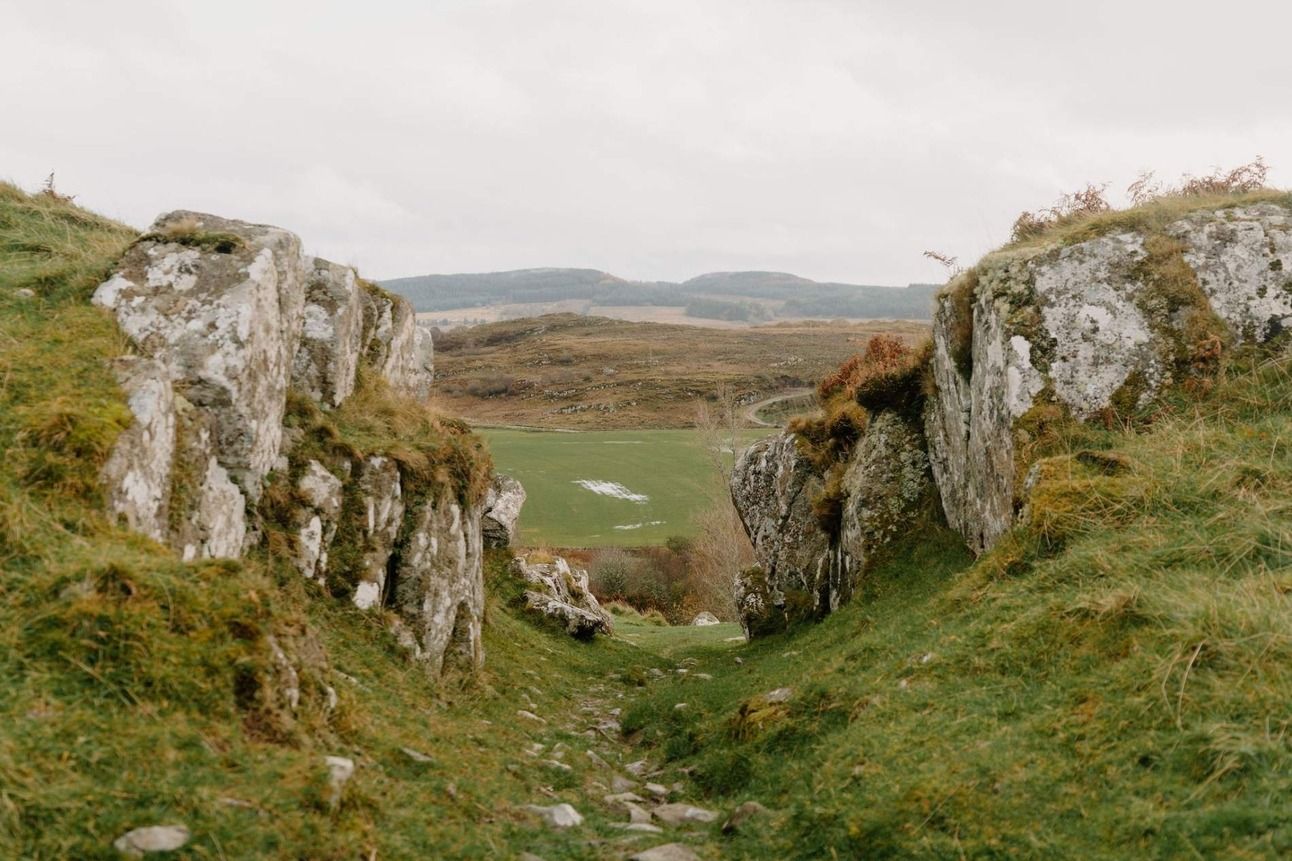
Dunadd Fort by Sam Rogers
Bridge Over The Atlantic
20 minutes drive from Oban
It might seem odd, but the trip south from Oban always starts for me with a journey across the Atlantic. Don’t worry, it only takes a few seconds by crossing the Clachan Bridge, otherwise known as The Bridge Over the Atlantic, to the island of Seil. This small sound of water connects to the Atlantic Ocean on either side, hence the nickname!
The pub beside the bridge is called Tigh an Truish or House of the Trousers, said to come from the years folowing the 1745 Jacobite Rising. Since locals weren’t allowed to wear kilts, they stopped at the pub to change into trousers before heading to the mainland!
Carnasserie Castle
45 minute drive
It’s a steep 10 minute hike uphill from the carpark, but reaching Carnasserie Castle is worth it! Built in the 16th century by John Carswell, it’s in remarkable condition considering it was abandoned around 100 years later. Carswell hired the same masons that had worked at Stirling Castle, so this was extreme luxury at the time.
Access is free and I’d recommend heading to the far tower, past the well and climbing to the very top of the ramparts. The views are incredible and make the hike up the hill worth the effort.
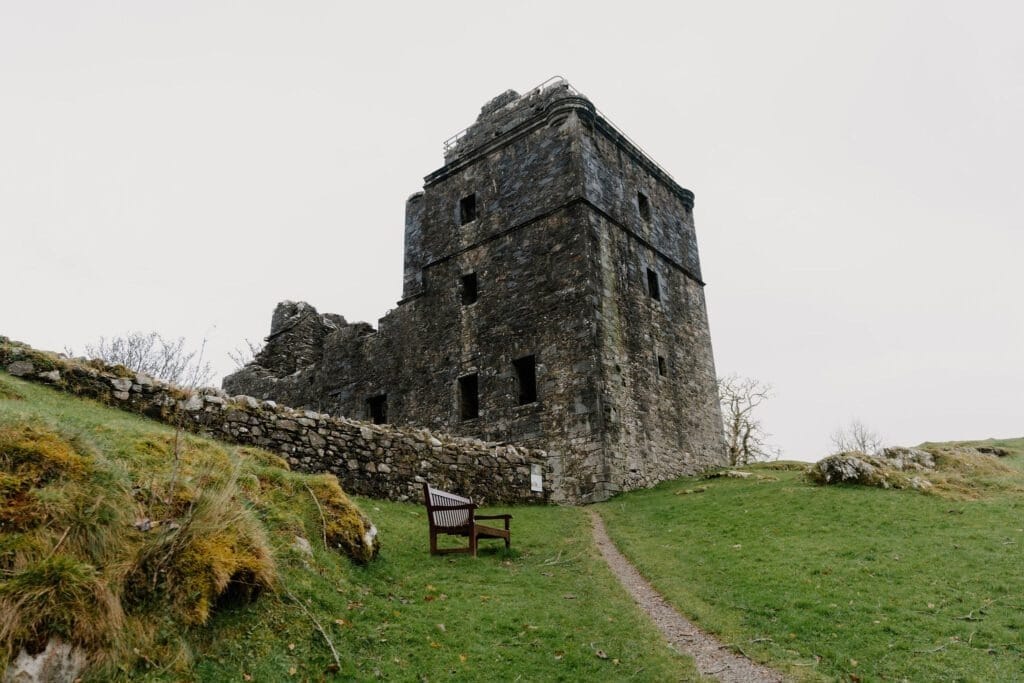
Kilmartin Graveslabs
5 minute drive
At first glance, Kilmartin Church is a typical Victorian building, but it replaced a series of much older churches and that’s evidenced towards the rear of the graveyard. Inside an old burial aisle stand dozens of incredible West Highland Graveslabs, dating from the 1300s onwards.
There are depictions of warriors in armour, elaborate swords and intricate Celtic knotwork surrounding them all. We don’t know exactly who they represent, but there will likely be many important Campbell clansmen amongst them.
Nether Largie Stones/Cairn/Temple
5 minute drive
If you have more time, then a walk around the Kilmartin Museum gives an excellent background to why Kilmartin Glen is a special place. Otherwise, this small area is packed with Neolithic monuments that you can explore at your own pace and I like to head straight for the Nether Largie Standing Stones.
Set up in a strange X-formation, they’re around 3500 years old and right at the middle of an ancient ceremonial landscape. It’s a short walk to Nether Largie Mid Cairn, an even older burial site and then Temple Wood, used for 2000 years in varying ways. We don’t know much about the people who lived here, but clearly Kilmartin was an important place.
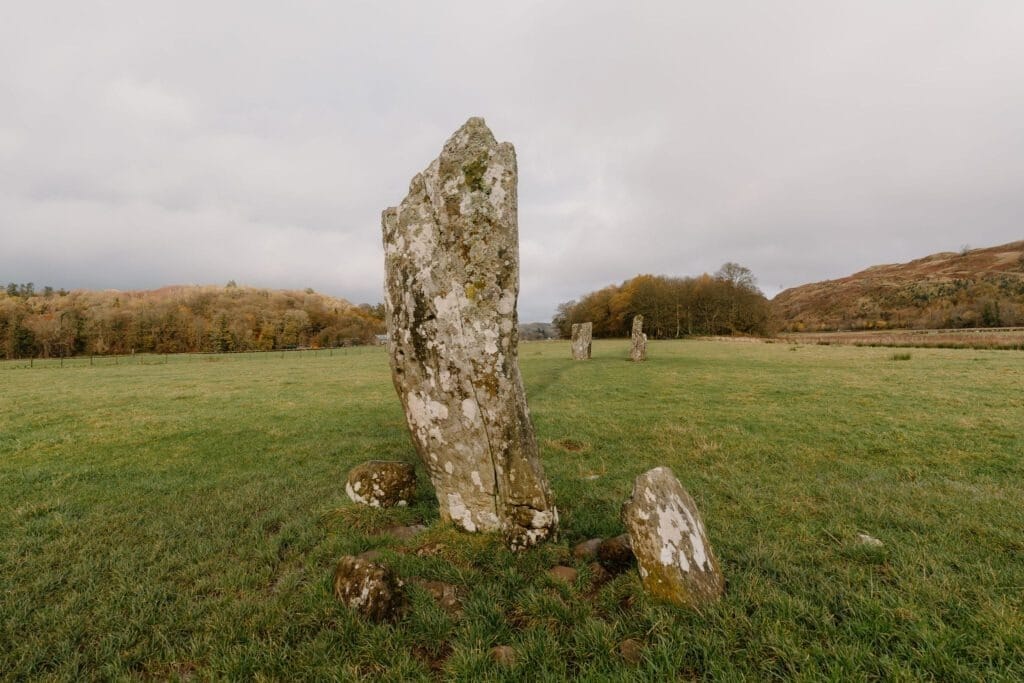
Lunch at Tayvallich Café
20 minute drive
Tucked away down one of Mid-Argyll’s many peninsulas, the Tayvallich Café is perfectly situated beside a small natural harbour on Loch Sween. No better place to enjoy soup and a sandwich!
Keills Chapel
15 minute drive
Carry on down the peninsula, through a farm gate (remember to close it behind you) and you’ll reach the parking area for Keills Chapel. Looking out to sea on a low rise, this 12th century chapel would have been used for regular Sunday worship for centuries, with people coming from miles around, many by boat!
Inside, surrounded by more carved graveslabs, stands the Keills cross. Created from blue slate around 1300 years ago, it stood outside where the replica is now since before the chapel was built. It’s an absolute masterpiece, with Celtic knotwork surrounding biblical scenes.
Kilmory Oib Cleared Village
25 minute drive
A short walk along a good track from Loch Coille Bharr car park through the woods leads to one of my favourite places in all of Argyll – Kilmory Oib. This village was home to over a dozen families for generations, living in drystone blackhouses and supporting themselves with small-scale farming.
Then in the 1800s, the village was cleared of people to make way for more profitable sheep. A path leads right through the middle to give you a closer look at the empty, overgrown houses that were once full of life.
Hike Up Dunadd
15 minute drive
Before Scotland existed as a country, this area was the heart of the Kingdom of Dalriada and Dunadd Fort was the capital of the Gaels. It’s a short but steep hike to the top, climbing through the old stone ramparts. You’ll need a bit of imagination to appreciate how this looked 1500 years ago, but the information boards help!
Near the top, a footprint has been carved in the rock that we believe was once used during coronations, connecting the new King with both the land and those who came before him. The views from here are vast, sweeping across Moine Mhor – the Great Moss – and it’s a powerful place to end a trip around Mid-Argyll!I
\If you’ve enjoyed this, you’ll find more of Graeme’s Scottish itineraries waiting on our site—each one focused on stories, routes, and places worth seeking out. [View them here].
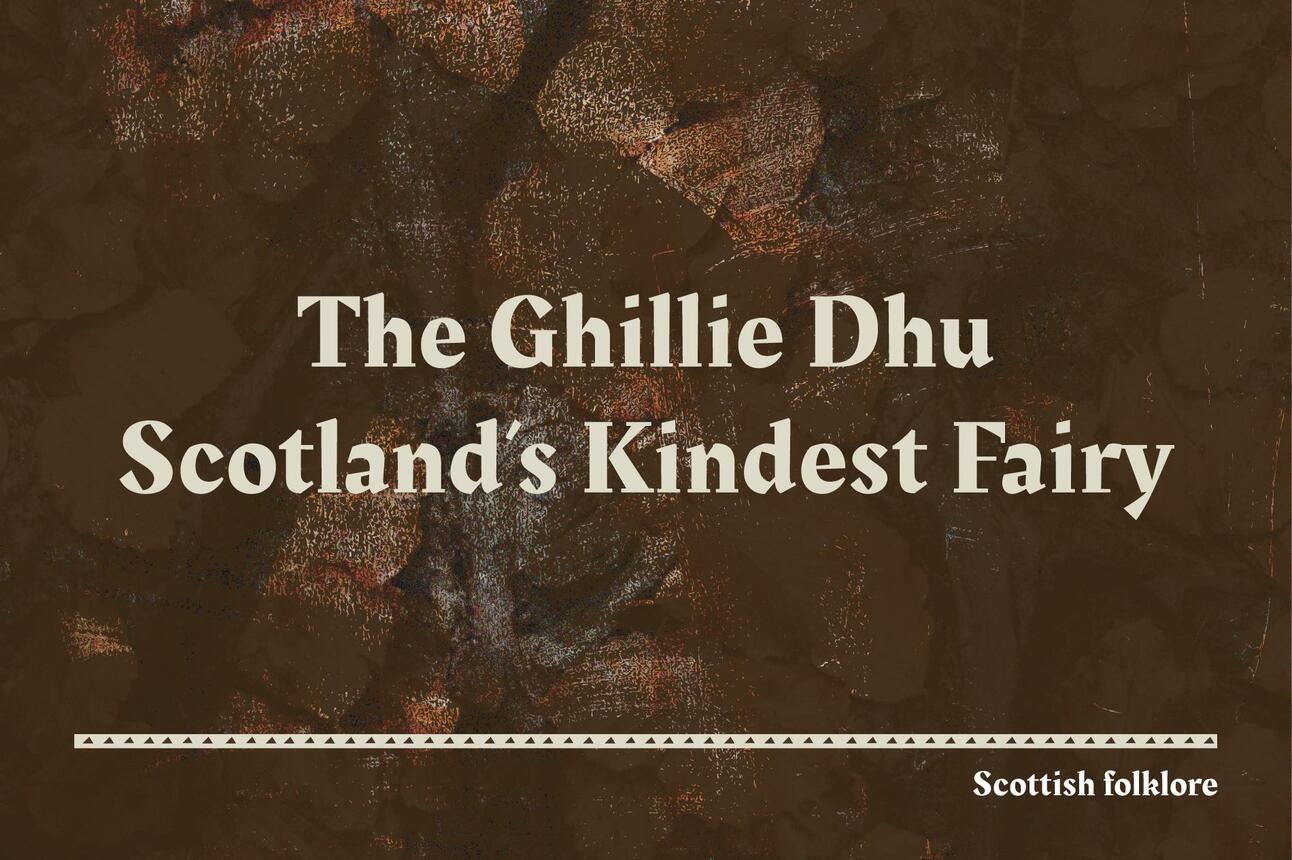
In the birch woods near Gairloch, a gentle figure once watched over lost children. Known as the Ghillie Dhu, this solitary fairy helped the young but kept his distance from adults—until one girl’s kindness may have saved him from vanishing forever.
Fairies have a terrible reputation for stealing children away to their hidden kingdom and leaving a changeling in their place. However, the Ghillie Dhu was known for doing the very opposite, as the legendary guardian of lost children.
He was a solitary fairy, with dark hair and clothed in nothing but leaves and moss, leading to the name Dhu, Gaelic for black. Nobody knows if there were once lots of these creatures or if this was a specific individual, but the Ghillie Dhu has only ever been seen in one location. He made his home in a quiet birch wood around Loch an Draing near Gairloch.
The Ghillie Dhu was sometimes wild and aggressive to adults who trespassed in his territory but was always very kind and protective of children. In the 18th Century, a young girl called Jessie Macrae wandered off on her own, getting hopelessly lost in these woods. As darkness began to fall, she sat down and started to cry.
Out of nowhere, the Ghillie Dhu appeared. This gentle fairy calmed the child down and guarded her while she slept amongst the trees for the night. In the morning, he led her back home to her worried parents, safe and sound.
The Ghillie Dhu was supposedly seen on numerous occasions however he refused to speak with anybody apart from Jessie. By the time she was a grown woman, the laird of the area, Sir Hector Mackenzie had decided to hunt down this strange fairy. He gathered a party of men to help with the sport and Jessie's husband was given the honour of hosting a feast for them the night before.
For some reason, over the next few days, the hunting party couldn't find any trace of their prey. It appears that Jessie had used the feast as a distraction to warn her old friend about what was coming for him. The Ghillie Dhu has never been seen since that day, possibly scared away from Gairloch for good.
This story was written by Graeme Johncock, to read more of Graeme’s Articles, stories and itineraries click here.
New Member Articles On the Site
Scotland’s Most Peaceful Beaches
Scotland’s quieter beaches are often the hardest to reach — and the most rewarding. We’ve picked ten of the most peaceful stretches of sand, from hidden island coves to wide northern bays. No facilities, no crowds — just sea, space, and silence. Read the full feature now on Hidden Scotland.
Scotland by Bike: 10 of the Best Trails to Ride
Scotland is made for slow travel, and there’s no better pace than by bike. This week, we’ve gathered ten of the country’s most rewarding routes—lochside paths, island loops, and quiet coastal roads—each with tips, details, and places worth stopping. Explore the full cycling feature now on Hidden Scotland.
The Moray Pictish Trail – 50 Miles of Stones, Forts, and Forgotten Symbols
Follow a route through Moray where carved stones, sea caves, and ruined forts reveal traces of a culture that left no written record. This new trail uncovers the Pictish presence along one of Scotland’s most atmospheric coastlines. Read the full itinerary now on Hidden Scotland.
Skye’s West Coast Café Trail – 30 Scenic Miles of Coffee, Cakes, Clifftops and Castles
This new Skye trail links cafés, cliffs, and quiet corners along 30 miles of the island’s west coast. From Neist Point to Talisker Bay, the focus is slow travel—local food, coastal walks, and places that reward time. Read the full self-guided route now on Hidden Scotland.
Clues in the Rock: What Dunadd Tells Us About Early Scotland
A carved footprint, ogham marks, and a summit once ringed by tidal water—Dunadd reveals more than it first lets on. This new article traces the site’s royal past and what remains today. Read the full story now and discover one of early Scotland’s most important, and enigmatic, strongholds.
This 6‑Stop Literary Trail Ends with a Drink at Rebus’s Favourite Pub
Edinburgh’s literary history runs through quiet courtyards, modern bookshops, and well-worn pubs. This new self-guided walk connects six memorable stops—from second-hand shelves to poetry underfoot—finishing at the Oxford Bar, the fictional haunt of Inspector Rebus. Read the full literary trail now, and walk the words through the capital.
25 of the Prettiest Towns and Villages in Scotland
From harbour towns with painted houses to hillside hamlets overlooking glens, Scotland has no shortage of good-looking places. We’ve picked 25 of the most photogenic villages—some well-known, others less so. Read the full list now and see which ones you’ve been to, and which are worth the trip.
Quiz Answers
Campbeltown
Betty Burke
Abbotsford House
Join now to play daily - New quiz drops every day at midnight.
We’ve also had a full restock of books in the Hidden Scotland Shop. You can browse the full selection here — but be quick, they tend to go fast.
Issue 10 Sponsors
It is with great pleasure that we introduce you to the sponsors of Issue 10.
We invite you to learn more about them by clicking their logo.
Did you like today's email?How can we improve? leave your feedback in the next step. |
If you would like to email us about any suggestions or feedback please email [email protected] with the subject feedback. Thanks!






